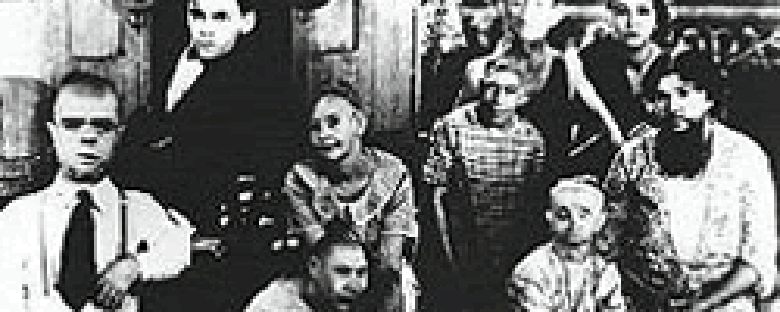Reviews
Tod Browning
USA, 1932
Credits
Review by Rumsey Taylor
Posted on 10 July 2004
Source Warner Bros. DVD
Related articles
resources: Rumsey Taylor’s favorite films
Freaks is foremost reputed as a horror film. Helmed by Tod Browning, whose prior films were immensely popular Hollywood horror films, Freaks is commonly presaged by the unique fact that it was banned in Britain for over thirty years. Its marketing promises a spectacle: “Can a full grown woman truly love a midget?” “Do Siamese twins make love?” “What sex is the half-man half-woman?” None of these questions are resolved in the film; like a circus ringleader, these taglines serve the exploitative purpose of hype — the viewer is to be appalled by the film’s inhumane contents. Certainly, horror is a justified classification in the case of Freaks, but it is ultimately conflictive with the film’s predominate sympathy.
Browning traveled the country in a circus in the late 1800s, an experience that would inform the body of his work as amainstream Hollywood director. His more notable films star Lon Chaney (London After Midnight) and Bela Lugosi (Dracula), both of whom displayed physical abnormalities in their roles. Despite the success and iconic renown of these films, specifically Dracula, Freaks is Browning’s masterpiece, and perhaps the most dynamic of all horror films.
The film occurs entirely in a circus. Cleopatra is a beautiful trapezist, Hercules her strongman lover. Amidst these talented and attractive performers are the members of the circus sideshow. There is Hans and Frieda, two midgets married to one another; The Half-Boy, with no lower extremities who is frighteningly lithe on his hands alone; and a group of “pinheads” with acutely-pointed craniums. The group includes the more familiar physical atrocities: a bearded lady, man-woman, and Siamese twins (each, incidentally, with a separate fiancé). Arguably the most astonishing of this group is The Living Torso; literally, a head attached to a large, limbless, sausage-like body. Midway through the film he lights a cigarette using only his mouth. (Adding to his list of capabilities, in the supplementary documentary Freaks: Sideshow Cinema, it is revealed the Torso, Prince Radian, was a husband and father of four children.)
Cleopatra begins to court Hans, a millionaire. For Hans this is a possibility for societal acceptance, although Cleopatra’s scheme is to fleece him of his fortune. Their engagement becomes controversial among the denizens of the circus — ironic, being that this is the one group capable of accepting the unlikely romance. In a standout scene subtitled “The Wedding Feast” Hans stages a dinner inviting Cleopatra, Hercules, and the sideshow performers. Cleopatra is capable of tolerating the freaks’ company, but she will not be associated with them. Angeleno, another midget, dances on the table towards Cleopatra, and offers her a sip from a community goblet. They chant “one of us,” and Cleopatra’s drunken cackle diminishes into the film’s first tangible expression of outright fear.
Browning attests that cosmetic security equips its benefactor with a biased perception of beauty — what doesn’t honor this perception is considered horrific. Responding with fright to the sideshow is identical to Cleopatra’s flaw of discrimination. The title refers, at first, to the sideshow characters (look closely at the title card and cartoon sketches of each can be seen around each letter), and ultimately to Cleopatra and Hercules. Finally, “freaks” describes the viewer who responds to this film with fright and no desire to understand or to sympathize.
Whereas “The Wedding Feast” is horrific because of its thematic connotation, Freaks’ final third is viscerally horrific. Up until this point, Browning’s sympathy for his disenabled cast (each of whom he allows an introduction of their handicap-cum-talent, and some of whom retain their actual names in the film) becomes further apparent. The film’s ending is an example of blatant exploitation, involving many of the less-mobile of the troupe crawling slowly through the mud towards the target of their revenge. The scenario is contrived as the horror of this image is rendered with embellishments (namely, a completely sporadic thunderstorm). This sequence is necessarily frightening, and, because it is so, functions to verify an intolerance that characterizes both the film’s villains and, in turn, its viewers. Despite the success of the freaks’ revenge, they are left alienated, and it is both a unique and tragic justice that they prescribe their own fate on their target by making her one of them. This denouement is a tragedy that will remain persistent as long as Freaks is considered a horror film.
We don’t do comments anymore, but you may contact us here or find us on Twitter or Facebook.



